
Krasnoyarsk is the largest city and administrative center of Krasnoyarsk Krai, Russia. It is situated along the Yenisey River, and is the second-largest city in Siberia after Novosibirsk, with a population of over 1.1 million. Krasnoyarsk is an important junction of the renowned Trans-Siberian Railway, and is one of the largest producers of aluminium in the country. The city is known for its natural landscape; author Anton Chekhov judged Krasnoyarsk to be the most beautiful city in Siberia. The Stolby Nature Sanctuary is located 10 km south of the city. Krasnoyarsk is a major educational centre in Siberia, and hosts the Siberian Federal University. In 2019, Krasnoyarsk was the host city of the 2019 Winter Universiade, the third hosted in Russia.
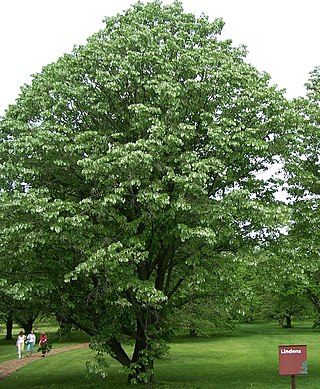
Tilia is a genus of about 30 species of trees or bushes, native throughout most of the temperate Northern Hemisphere. The tree is known as linden for the European species, and basswood for North American species. In Britain and Ireland they are commonly called lime trees, although they are not related to the citrus lime. The genus occurs in Europe and eastern North America, but the greatest species diversity is found in Asia. In Chinese, "椴/duàn" or "椴樹/duànshù" is a general term for Tilia species. Under the Cronquist classification system, this genus was placed in the family Tiliaceae, but genetic research summarised by the Angiosperm Phylogeny Group has resulted in the incorporation of this genus, and of most of the previous family, into the Malvaceae.
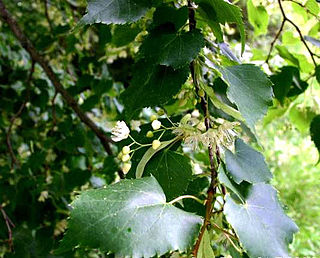
Tilia cordata, the small-leaved lime or small-leaved linden, is a species of tree in the family Malvaceae, native to much of Europe. Other common names include little-leaf or littleleaf linden, or traditionally in South East England, pry or pry tree. Its range extends from Britain through mainland Europe to the Caucasus and western Asia. In the south of its range it is restricted to high elevations.

Tilia platyphyllos, the large-leaved lime or large-leaved linden, is a species of flowering plant in the family Malvaceae (Tiliaceae). It is a deciduous tree, native to much of continental Europe as well as southwestern Great Britain, growing on lime-rich soils. The common names largeleaf linden and large-leaved linden are in standard use throughout the English-speaking world except in the British Isles, where it is known as large-leaved lime. The name "lime", possibly a corruption of "line" originally from "lind", has been in use for centuries and also attaches to other species of Tilia. It is not, however, closely related to the lime fruit tree, a species of citrus.

Lawsonia inermis, also known as hina, the henna tree, the mignonette tree, and the Egyptian privet, is a flowering plant and one of the only two species of the genus Lawsonia, with the other being Lawsonia odorata. The species is named after the Scottish physician Isaac Lawson, a good friend of Linnaeus.
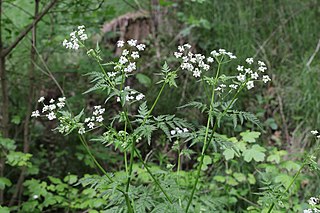
Anthriscus sylvestris, known as cow parsley, wild chervil, wild beaked parsley, Queen Anne's lace or keck, is a herbaceous biennial or short-lived perennial plant in the family Apiaceae (Umbelliferae), genus Anthriscus. It is also sometimes called mother-die, a name that is also applied to the common hawthorn. It is native to Europe, western Asia and northwestern Africa. It is related to other diverse members of Apiaceae, such as parsley, carrot, hemlock and hogweed. It is often confused with Daucus carota, another member of the Apiaceae also known as "Queen Anne's lace" or "wild carrot".

Tilia americana is a species of tree in the family Malvaceae, native to eastern North America, from southeast Manitoba east to New Brunswick, southwest to northeast Oklahoma, southeast to South Carolina, and west along the Niobrara River to Cherry County, Nebraska. It is the sole representative of its genus in the Western Hemisphere, assuming T. caroliniana is treated as a subspecies or local ecotype of T. americana. Common names include American basswood and American linden.
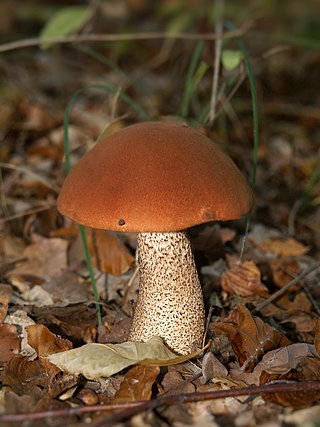
Leccinum aurantiacum is a species of fungus in the genus Leccinum found in forests of Eurasia and North America. It has a large, characteristically red-capped fruiting body. In North America, it is sometimes referred to by the common name red-capped scaber stalk. Some uncertainties exist regarding the taxonomic classification of this species in Europe and North America. It is considered edible, but must be cooked thoroughly.

Alstonia scholaris, commonly called blackboard tree, scholar tree, milkwood or devil's tree in English, is an evergreen tropical tree in the Dogbane Family (Apocynaceae). It is native to southern China, tropical Asia and Australasia, where it is a common ornamental plant. It is a toxic plant, but is used traditionally for myriad diseases and complaints.
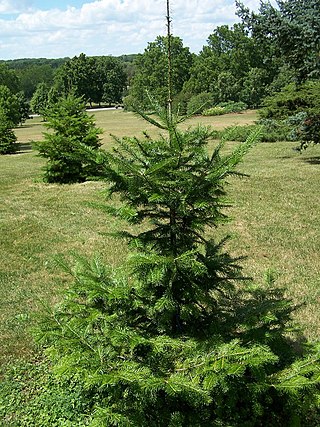
Abies nephrolepis, commonly known as Khingan fir, is a species of fir native to northeastern China, North Korea, South Korea, and southeastern Russia.

Anacolosa densiflora is a species of plant in the Olacaceae family. Currently, it is an endangered species that is endemic to India.

Tilia × europaea, generally known as the European lime, common lime or common linden, is a naturally occurring hybrid between Tilia cordata and Tilia platyphyllos. It occurs in the wild in Europe at scattered localities wherever the two parent species are both native. It is not closely related to the lime fruit tree, a species of citrus.

Tilia tomentosa, known as silver linden in the US and silver lime in the UK, is a species of flowering plant in the family Malvaceae, native to southeastern Europe and southwestern Asia, from Romania and the Balkans east to western Turkey, occurring at moderate altitudes.

Ramalina fraxinea, the cartilage lichen, is a fruticose lichen with erect or pendulous thalli and branches that are flattened. Colour varies from pale green though yellow-grey to white-grey; apothecia are frequent and soralia may also be present.

Callipogon relictus is a species of longhorn beetle which is mostly found in Korea, but also in China and southern part of Russian Far East. It inhabits mixed and deciduous forests. The population of Callipogon relictus is decreasing due to deforestation and uncontrolled collection, and therefore the species are listed in the Russian Red Book.

Lilium concolor is a species of flowering plant in the lily family which occurs naturally in China, Japan, Korea and Russia. Its relationship with other species is not clear, although it has some similarities to Lilium pumilum.
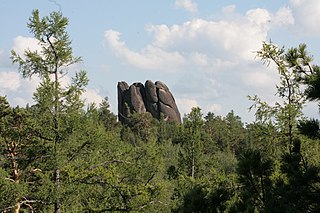
Krasnoyarsk Pillars is a Russian national park located 10 km south of the city of Krasnoyarsk, on the northwestern spurs of the Eastern Sayan Mountains. The site is known for its dramatic rock formations. Over 200,000 climbers, hikers, and other visitors are recorded annually. The park covers 47,219 hectares.
Iris ventricosa is a beardless iris in the genus Iris, in the subgenus Limniris and in the series Tenuifoliae of the genus. It is a rhizomatous herbaceous perennial, from Asia and the Russian Federation, to Mongolia and China. It has grey-green leaves, short flowers stems and 1–2 pale violet or pale blue flowers.

Iris acutiloba is a species in the genus Iris, it is also in the subgenus of Iris and section Oncocyclus. It is a rhizomatous perennial, from the mountains of the Caucasus and found in Turkey, Armenia, Azerbaijan, Turkmenistan, Dagestan in the North Caucasus, and Iran. It is a dwarf species, with narrow, falcate or curved leaves, it has one flower in spring or early summer, that comes in shades from cream, creamy white, whitish, pale brown, light grey, to pale violet. It is heavily veined or streaked and pointed, with 2 dark spots and brown, purple, dark purple, or black short beard. It is cultivated as an ornamental plant in temperate regions. There are two subspecies, Iris acutiloba subsp. lineolata and Iris acutiloba subsp. longitepala.

Tilia amurensis, the Amur lime or Amur linden, is a species of Tilia native to eastern Asia. It differs from the better-known Tilia cordata in having somewhat smaller leaves, bracts and cymes. It is an important timber tree in Russia, China and Korea, and is occasionally planted as a street tree in cities with colder climates.




















